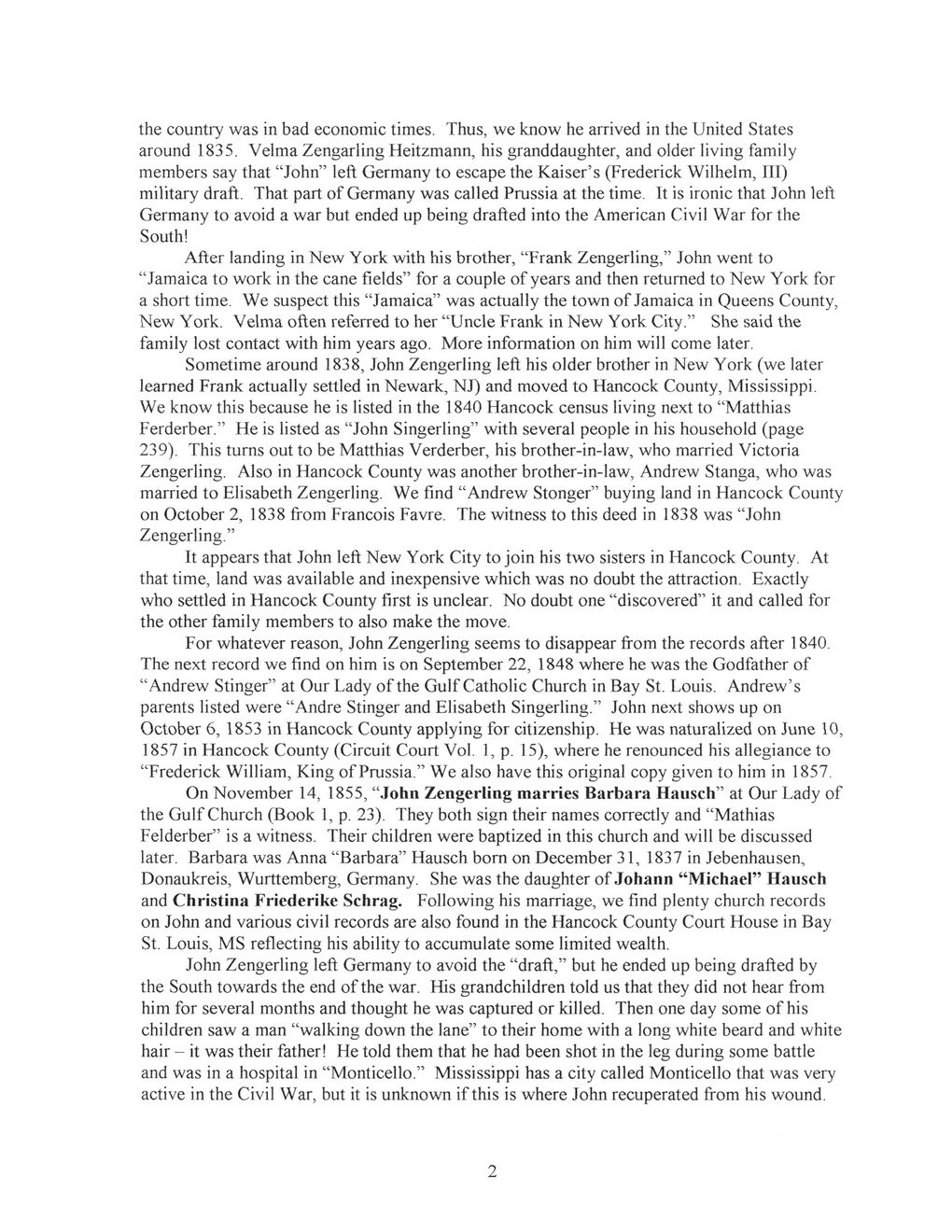This text was obtained via automated optical character recognition.
It has not been edited and may therefore contain several errors.
the country was in bad economic times. Thus, we know he arrived in the United States around 1835. Velma Zengarling Heitzmann, his granddaughter, and older living family members say that ?John? left Germany to escape the Kaiser?s (Frederick Wilhelm, HI) military draft. That part of Germany was called Prussia at the time. It is ironic that John left Germany to avoid a war but ended up being drafted into the American Civil War for the South! After landing in New York with his brother, ?Frank Zengerling,? John went to ?Jamaica to work in the cane fields? for a couple of years and then returned to New York for a short time. We suspect this ?Jamaica? was actually the town of Jamaica in Queens County, New York. Velma often referred to her ?Uncle Frank in New York City.? She said the family lost contact with him years ago. More information on him will come later. Sometime around 1838, John Zengerling left his older brother in New York (we later learned Frank actually settled in Newark, NJ) and moved to Hancock County, Mississippi. We know this because he is listed in the 1840 Hancock census living next to ?Matthias Ferderber.? He is listed as ?John Singerling? with several people in his household (page 239). This turns out to be Matthias Verderber, his brother-in-law, who married Victoria Zengerling. Also in Hancock County was another brother-in-law, Andrew Stanga, who was married to Elisabeth Zengerling. We find ?Andrew Stonger? buying land in Hancock County on October 2, 1838 from Francois Favre. The witness to this deed in 1838 was ?John Zengerling.? It appears that John left New York City to join his two sisters in Hancock County. At that time, land was available and inexpensive which was no doubt the attraction. Exactly who settled in Hancock County first is unclear. No doubt one ?discovered? it and called for the other family members to also make the move. For whatever reason, John Zengerling seems to disappear from the records after 1840. The next record we find on him is on September 22, 1848 where he was the Godfather of ?Andrew Stinger? at Our Lady of the Gulf Catholic Church in Bay St. Louis. Andrew?s parents listed were ?Andre Stinger and Elisabeth Singerling.? John next shows up on October 6, 1853 in Hancock County applying for citizenship. He was naturalized on June 10, 1857 in Hancock County (Circuit Court Vol. 1, p. 15), where he renounced his allegiance to ?Frederick William, King of Prussia.? We also have this original copy given to him in 1857. On November 14, 1855, ?John Zengerling marries Barbara Hausch? at Our Lady of the Gulf Church (Book 1, p. 23). They both sign their names correctly and ?Mathias Felderber? is a witness. Their children were baptized in this church and will be discussed later. Barbara was Anna ?Barbara? Hausch bom on December 31, 1837 in Jebenhausen, Donaukreis, Wurttemberg, Germany. She was the daughter of Johann ?Michael? Hausch and Christina Friederike Schrag. Following his marriage, we find plenty church records on John and various civil records are also found in the Hancock County Court House in Bay St. Louis, MS reflecting his ability to accumulate some limited wealth. John Zengerling left Germany to avoid the ?draft,? but he ended up being drafted by the South towards the end of the war. His grandchildren told us that they did not hear from him for several months and thought he was captured or killed. Then one day some of his children saw a man ?walking down the lane? to their home with a long white beard and white hair - it was their father! He told them that he had been shot in the leg during some battle and was in a hospital in ?Monticello.? Mississippi has a city called Monticello that was very active in the Civil War, but it is unknown if this is where John recuperated from his wound. 2

Zengerling, Johannes (John) Ancestors and Descendants-03